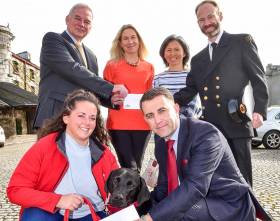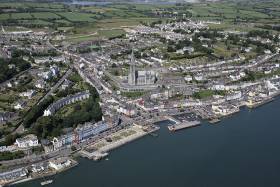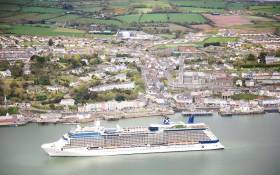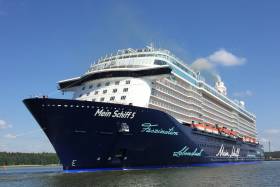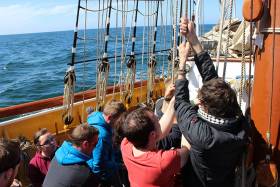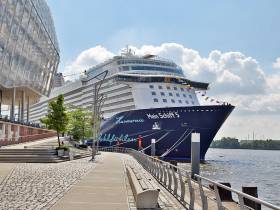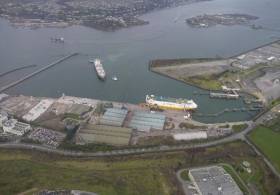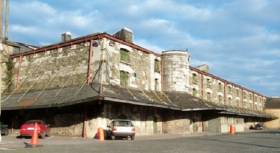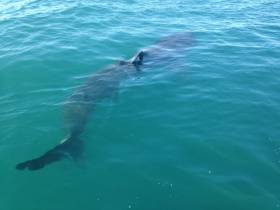Displaying items by tag: port of Cork
Port of Cork Cyclists Raise Valuable Funds for Two Charities
The Port of Cork had a team of over 90 cyclists who recently completed the An Post Rebel Tour cycle from Glengarriff. Cyclists from a range of port related companies took part in the cycle which was co-sponsored by the National Maritime College of Ireland (NMCI) and Zenith Energy Management Ltd. Together the cyclists raised over €1800 for Autism Assistance Dogs Ireland and over €1100 for the Seamen’s Christian Friends Society.
Cyclists chose either 85km or 160km routes across which led them to West Cork and into Kerry.
Brendan Keating, Port of Cork Chief Executive said: “This is our third year organising the cycle which was by far the biggest turnout of cyclists to date. We were delighted to partner with NMCI and Zenith Energy Management Ltd and as result two very deserving charities benefitted from our cyclists generous donations.’
He continued: ‘I’d like to congratulate all those who took part and thank you for your kind donations.’
The Seamen’s Christian Friend Society (SCFS) is based in 40 ports around the world and spends their days boarding ship after ship, meeting and assisting crews. Over a million men and women live in the twilight world of big shipping and it’s a lonely life roaming the world's oceans for up to 12 months at a time. An SCFS Friend brings a welcome, an offer of friendship or a chance for a sympathetic talk and news of the Christian gospel to crews.
Autism Assistance Dogs Ireland is a national charity providing highly trained assistance dogs for children with autism and their families. The dogs are specially trained to provide safety, independence and companionship to children who would otherwise live in a very isolated world. These dogs help to transform the lives of children and their families.
Cobh Named One of Western Europe’s Best Cruise Destinations for British Isles & Western Europe
Cruise Critic, a world leading cruise review site and online cruise community, has announced the winners of the inaugural Cruise Critic Cruisers’ Choice Destination Awards with Cork harbour’s Cobh ranked second favourite cruise destination in the British Isles and Western Europe.
As Afloat.ie reported yesterday, The awards name the best cruise destinations of the year – across 15 regions around the world – based entirely on reviews posted by cruise passengers to the Cruise Critic website.
For the British Isles and Western Europe awards, Amsterdam was rated top, while Cork’s Cobh and Glasgow’s Greenock ranked second and third respectively.
These awards recognise the high level of effort that goes into ensuring every cruise passenger visiting Cobh has a memorable visit to the region. With the awards based solely on passenger feedback there is no ambiguity around results – what you read is what you get!
Captain Michael McCarthy, Commercial Manager, Port of Cork said: “We are simply thrilled with the result for Cobh. Every year the Port of Cork puts a huge amount of effort into preparing and promoting the Cork region to the cruise companies and their passengers and this has really paid off.’
He continued: ‘This is an example of a genuine collaborative team effort. It could not be done without an extremely dedicated group of people who believe in our destination. Prior to the vessels arrival the port company promotes the region’s attractions directly to cruise passengers on board the liners. Once the liner arrives, our Port Pilot steps on board and really this is the beginning of the welcome. From there we offer tourism ambassadors on every liner, local entertainment and then, as their visit ends we have the Cobh Brass band on the quayside as the liner departs.’
‘This award is about a port and a City working together to make the passenger experience entirely better.’ One cruise passenger who commented said “Beautiful city with very friendly locals.” what more could we ask for.’
According to Adam Coulter, UK editor, Cruise Critic: “A cruise isn’t just about the ship – picking the right itinerary is imperative. Cruises enable travellers to explore a number of amazing destinations, offering culture, beauty and history. With such a variety of unique destinations to choose from, these awards aim to highlight, and celebrate, those rated highly by travellers to offer inspiration and guidance to cruise planners.”
The Port of Cork cruise business continues to go from strength to strength with 58 cruise calls this year and 66 cruise calls expected in 2017. To date 118,000 passengers and crew have visited the region and with a further seven liners due to call, these numbers will increase.
Cork's Cobh Listed in Top Three Destinations In Worldwide Cruise Critic Traveller Awards
#CobhAward – TripAdvisor which owns Cruise Critic, the world's largest cruise review site and online cruise community, has announced Cobh as among the winners of the inaugural Cruise Critic Cruisers’ Choice Destination Awards.
In the British Isles and Western Europe awards, Cork’s Cobh was ranked second place, Glasgow’s Greenock ranked third, leaving Amsterdam to top the list in first place, with calls to the Dutch destination from the likes of Regent Seven Seas and Azamara Club Cruises.
The awards name the best cruise destinations of the year – across 15 regions around the world – based entirely on reviews posted to the Cruise Critic website. All rankings are based on member review ratings for ports from sailings taken August 1, 2015 to July 31, 2016.
“A cruise isn’t just about the ship – picking the right itinerary is imperative,” explains Adam Coulter, UK editor, Cruise Critic. “Cruises enable travellers to explore a number of amazing destinations, offering culture, beauty and history. With such a variety of unique destinations to choose from, these awards aim to highlight, and celebrate, those rated highly by travellers to offer inspiration and guidance to cruise planners.”
Popular ports include the Caribbean’s St. Maarten, which receives visits from lines including P&O Cruises, Royal Caribbean and MSC Cruises, and Alaska’s Glacier Bay which is visited by a number of cruise lines including Norwegian Cruise Line and Holland America Line.
The British love the Baltics - UK travellers rated Baltic destinations in their top three, with Stockholm first, followed by Tallinn and Copenhagen.
Winds of Change Channel New Cruiseship Call to Cobh Instead of Capital
#WindsofChange – Afloat.ie has monitored Mein Schiff 5 movements noting the new cruiseship less than two months in service was forced to change its first ever call to an Irish port today, writes Jehan Ashmore.
It transpired that high winds forecast at Dublin Port were the cause and so the 2,750 passenger cruiseship had to call to Cobh, where the 295m newbuild berthed this morning but was due to call anyway tomorrow. Cruisegoers will not be left dissappointed as the near 100,00 gross tonnage ship will be simply swapping ports with the scheduled call to the capital a day later.
The impact of windage on the TUI Cruises newest ship with 15 decks high had to be considered when berthing in the confines of Dublin Port, where most callers are to Alexandra Basin.
Dublin Port Company’s first ever cruise terminal costing €30m is part of the Alexandra Basin Redevelopment Project (ABR) which is been built to accommodate even larger cruiseships and following a major dredging channel campaign.
A reconfiguration of quays will enable these mega cruiseships to call using an increased turning circle though at the expense of demolishing the end of the North Wall Quay Extension.
More quayside space and adjacent hard standing for cargo space, however will be made with the infilling of the Dublin Graving Docks that closed in April.
The ABR project is phase one of DPC plans to also permit increasingly larger cargsoships and associated deeper drafts to enter the port, so to meet demands of throughput which is forecast to rise, as the port in 2015 alone experienced record breaking volumes.
The 220m graving dock is nearby to where these mega cruiseships will dock at the two-berth terminal and much closer to city-centre, been next to the Tom Clarke toll-bridge.
Tall Ship Celebrations for Cork Sail Training Bursary Scheme
32 young people from all backgrounds and a range of abilities across Cork City and County who have completed Tall Ship voyages aboard the Cork-Based Vessel Spirit of Oysterhaven and the Dutch Tall Ship Morgenster during the 2016 season will celebrate their achievements in Cork today.
The voyages were made possible by the assistance of a group of sponsors including Port of Cork, Cork City Council, Cork County Council, EMC, Ardmore Shipping, The Institute of Master Mariners and the National Maritime College of Ireland.
Due to extra support from Port of Cork, Cork County Council and Cork City Council Morgenster made a visit to Cork in June and hosted events and “open-ship” for public visits in Cork City and in Cobh during the Cork Harbour Festival 2016.
13 trainees from the City and County sailed the ship over 12 days from Belfast, via Isle of Man to Cork. Another 3 Cork trainees sailed from Cork to Amsterdam over 19 days arriving in Amsterdam at the end of June. These trainees formed part of groups with up-to 32 trainees and mentors on each voyage which were part funded using EU “Erasmus +” funding and involved active educational programmes of youth development as part of “Youth Exchange” projects.
The Cork Sail Training Bursary Scheme was established in 2014 to provide access to Sail Training voyages on tall ships and large sailing vessels for young people from the region. Now in its third year the scheme is one of the largest and most active on the Island of Ireland and runs in parallel with similar schemes now in operation under Sail Training Ireland in Belfast, Drogheda, Dublin, Waterford, Wexford, Limerick and Galway. The participants are nominated through a network of youth and community groups in Cork and places are available to young people from all backgrounds and with all abilities.
The scheme has supported approximately 50 trainees since 2014 and looks likely to grow from strength to strength over the coming years.
Also present on the day will be trainees sponsored under one of Sail Training Ireland’s “SafeHaven Voyages” sponsored by “Arthur Cox”. Their voyage on board the “Spirit of Oysterhaven” finishes today, following six days at sea beginning in Glandore County Cork. The vessel will be in Port of Cork and open to visitors after the event.
“The whole experience since we first met until the last moment I will never forget. The scenery, the sea sickness, the lifestyle and most of all the people I spent this journey with. I’ve made some lovely friends and will never forget them.” Cork Trainee 2015.
MC for the event is RTE Radio “SeaScapes” Presenter Marcus Connaughton (Goodwill Ambassador for Sail Training Ireland) and the certificates will be presented to trainees by Commodore Hugh Tully - Flag Officer Commanding Naval Service (F.O.C.N.S.). The Naval Service is a strong supporter of Sail Training for young people as a stepping stone into maritime careers and has recently made the Naval Yacht “Creidne” available for voyages for young people selected by Sail Training Ireland.
Come In Channel No.5 As Irish Ports Await Arrival of Another Big Brand New Cruiseship
#NewestShip – Afloat.ie has tracked another big brand new cruiseship, Mein Schiff 5 that is to make a first call to an Irish port tomorrow, reflecting the growing demand for such visits and related infrastructural developments, writes Jehan Ashmore.
Mein Schiff 5 towering 15 decks and almost 100,000 gross tonnage is TUI Cruises' latest fleet member with a 2,750 passenger capacity that is to make a debut to Dublin Port before dawn.
After her visit to the capital, passengers have no less than 13 restuarants and bistros dining options to choose, before it will be the Port of Cork’s turn to welcome the latest newcomer to Cobh on Saturday. Both Dublin through its new cruise terminal development and Cobh’s upgrade are to meet the berthing requirements of even much larger cruiseships.
Today, Mein Schiff is berthed at the Port of Holyhead from where had arrived from the UK’s premier cruise port of Southampton.
In July, the 295m vessel was named Mein Schiff 5 at a ceremony in Lübeck/Travemünde. It was at nearby Kiel, she sailed across the Baltic Sea for her maiden voyage to Stockholm, calling at Tallinn, St. Petersburg and Helsinki.
The newest addition brings to a total of 14 cruiseships for TUI Group, a hotel and cruise group that was initiated at the end of 2014 and includes the rebranding of the UK operator, Thomson Cruises. Mein Schiff 5 is the Group’s third new build, and in June was handed over 10 days ahead of scheduled at the Meyer Turku shipyard, Finland to subsidiary TUI Cruises.
Like TUI Cruises’ other newbuilds, Meins Schiff 5 is a low-vibration vessel, which uses state of the art technologically that will enhance a pleasant environment for her guests. She has a 280m jogging track and 25m swimming pool.
In terms of operational efficiency, there is 30% less energy consumption and therefore 30% less fuel than other cruiseships of a comparable size.
Towards the end of the construction period, work simultaneously began on the construction of another sister, Mein Schiff 6. Meyer Turku were also involved in the construction of predecessor, Mein Schiff 4 launched in 2014.
In the following year, Mein Schiff 4 made a first call to Dun Laoghaire with an anchorage much closer to the harbour compared to other callers of recent years. The south Dublin Bay port still awaits a planning decision on the controversial cruise-berth to enable such sized ships and even larger to dock within the harbour.
Plans for New €15m Berth to be Cobh’s Quay to Success
#NewBerth - A new €15m deep-water quay in Cobh is in the planning by the Port of Cork, to handle the increasing number of large cruise liners expected to arrive in the near future.
The Irish Examiner writes the port company have confirmed a record 66 liners are already booked to dock in the harbour next year, and the figure could well top 70 as the larger Quantum class vessels may yet announce their intention to visit.
The scheduled 66 ships will carry 170,000 passengers in total and, on average, they are expected to directly spend €73 each while ashore bringing a potential boost of €12.41m to the local economy.
Port of Cork commercial manager Captain Michael McCarthy said the company was planning to reach a target, by 2020, of attracting 75 cruise ships annually but it could be achieved earlier as business prospects are very encouraging.
The newspaper details more about the new cruise-berth here
Boost to Port of Cork With Profits Up 79%
#ProfitsUp - The Port of Cork through increased activity saw profits increase by 79% to almost €4.5m last year, reports the Irish Examiner.
The State-owned company, which oversees port operations in Cork, saw revenue from charges to port users and property rental increase by 12.9% to €29.8m.
Ireland’s second busiest port also reported growth in the volume of goods passing through Cork in 2015 – up 8.6% to 11.02 million tonnes – although there was a slight decrease in the actual number of vessels – down 10 to 1,174.
In its annual report the company welcomed the decision by An Bord Pleanála, last May, to grant planning permission for a €100m redevelopment at Ringaskiddy which it described as a “critical infrastructure project”.
To read more click here
#PortCorkSite - Elected representatives were dismayed to be told yesterday that Cork City Council does not have plans for the historic site, which was once earmarked for a National Diaspora Centre.
The Evening Echo reports that in recent weeks, the Port of Cork listed the 2.9 acre site at the entrance to the city on the market for approximately €7 million. The site includes the old Custom House and the Bonded Warehouses.
It was hoped that a bid may be forthcoming from the local authority in order to transform the site into a critical piece of tourism infrastructure for Cork, though this now seems unlikely.
Officials from City Hall informed councillors at last night’s meeting of Cork City Council that it is ‘not in a position to fund the acquisition’ of the site.
A spokesperson for City Hall told councillors that, “The City Council does not have a plan for the Cork Harbour Commissioners building which is currently for sale on the open market following a decision by the Port of Cork company to put it on the market.
“The City Council is not in a position to fund the acquisition of the property, nor to develop the premises as a maritime or diaspora centre.”
To read further on this story, click here.
Basking Shark Arrives in Cork Harbour For Harbourfest16
Port of Cork posted this picture of the 'biggest' basking shark in Cork Harbour today, presumably enjoying #corkharbourfest16 that includes the Ocean to City race.


























